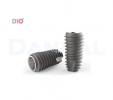Most North American dentists offer implant services to their patients. There has been a tendency by general practitioners to refer the surgical phase (though it is not technically difficult) to periodontists, oral surgeons, and implant-trained general practitioners. The increasing prevalence of CBCT diagnostics, reliably predictive implant positioning software, and mechanically integrated surgical stents have made the routine implant placement procedure more accessible and attractive to GPs. Internationally, most implants are surgically placed by GPs.
Many of the original implant patents have expired, encouraging the rapid entry of new implant manufacturers, increasing competition and decreasing fixture and accessory costs, a benefit to patients and dentists. Today, 70% of all dental implants placed worldwide are sold by lower-cost manufacturers. On another front, some insurers have begun to offer partial or significant benefit coverage, recognizing that implant therapy has a very long-term value.
Dentists tend to adopt innovative concepts reluctantly and slowly, waiting for reliable clinical validation. There is no question that this caution, born of long experience, slowed the acceptance of implant therapy. Another significant barrier was the implant industry’s initial distribution model, a misguided policy that exclusively targeted specialists, intentionally shutting GPs out. This decision alone likely slowed the use and acceptance of implants in North America by a full decade. Fortunately for patients and the profession, implant dentistry has been mainstreamed and simplified during the last 35 years. GPs now diagnose and treat the majority of implant cases.
More than 100 million Americans are older than 50 and at least 25% wear at least one removable prosthesis. More than 80 million have one or more unrestored missing tooth. All these individuals require tooth replacement therapy and many can afford it. Implants offer the best, longest lasting, and most cost-effective long-term treatment options. Baby boomers are at the peak of their earnings and asset curves. They are also committed to optimal personal health and well-being. Many of them, however, are also unaware of the potential benefits of implant therapy and require active education from the dental team.
Connectors
Connectors are anti-rotation mechanisms that are built into the implant system. The most common types are external (of varying sizes) and internal (including the internal hex and the Morse taper).
Style and Shape
The manufacturers encourage the surface osseointegration with various implant shapes, typically cylinder-shaped or tapered, that adapt to the anatomy of the remaining bone. A 3-D threading of the external implant surface may increase its retention.
Surface Finish
The texture of the implant surface that interfaces with the bone and the soft tissues is machined, cast, and/or cut by microlathes to a particular shape, often resembling a threaded screw. These surfaces may be coated with hydroxyapatite (HA) or Titanium Plasma Spray (TPS), or they may be textured by air abrasion or acid etching.
Diameter
The varied indications for implants dictate many sizes. Some implants have a uniform implant diameter. Some flare near the osseous crest to provide a larger platform. The size of the antirotation mechanism often dictates the diameter. External hexes may be standardized within a system or they may vary.
Primary Use
The intended format (fixed or removable) of the final restoration dictates the positioning and the implant type.
Removable Fixtures
Provisional implants may retain a transitional prosthesis during the permanent implants/grafts healing time, protecting the implants and grafts from trauma during the healing process by providing vertical functional stops.
Prosthetic Retention
The prosthetic retention to the osseointegrated implant may be fixed, screw-retained, removable, or cement-retained. The retention is determined by the intended function.
Copings
Impression copings transfer the exact positioning of the implant in the mouth to a stone model. For the open tray (direct method), the copings are unscrewed from the implant and removed with the impression tray. With the closed tray (indirect method), the copings are removed after the tray and then repositioned in the impression.
Abutment Design
The abutment design facilitates the restorative procedure. Hexed abutments engage the antirotation mechanism. Nonhexed abutments use various physics principles to prevent inadvertent rotation. Where the implant infrastructure and the overlying restoration are well aligned, straight abutments are indicated. Angled abutments can redirect the functional and nonfunctional forces where misalignment exists.

